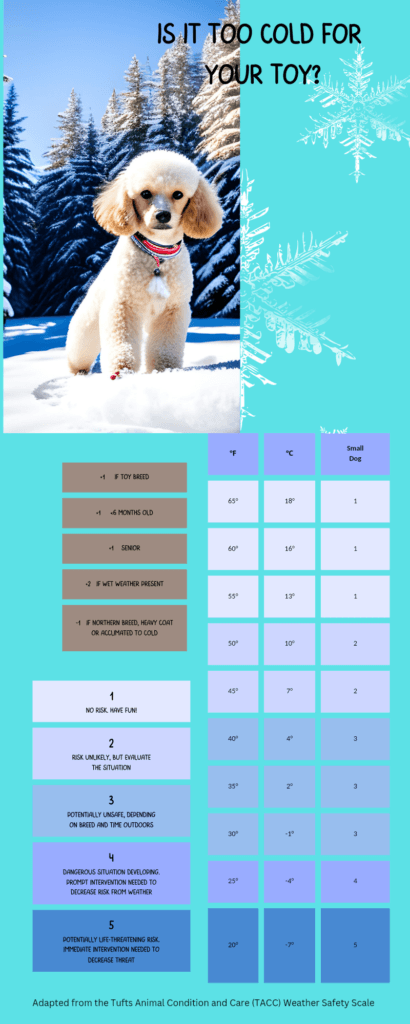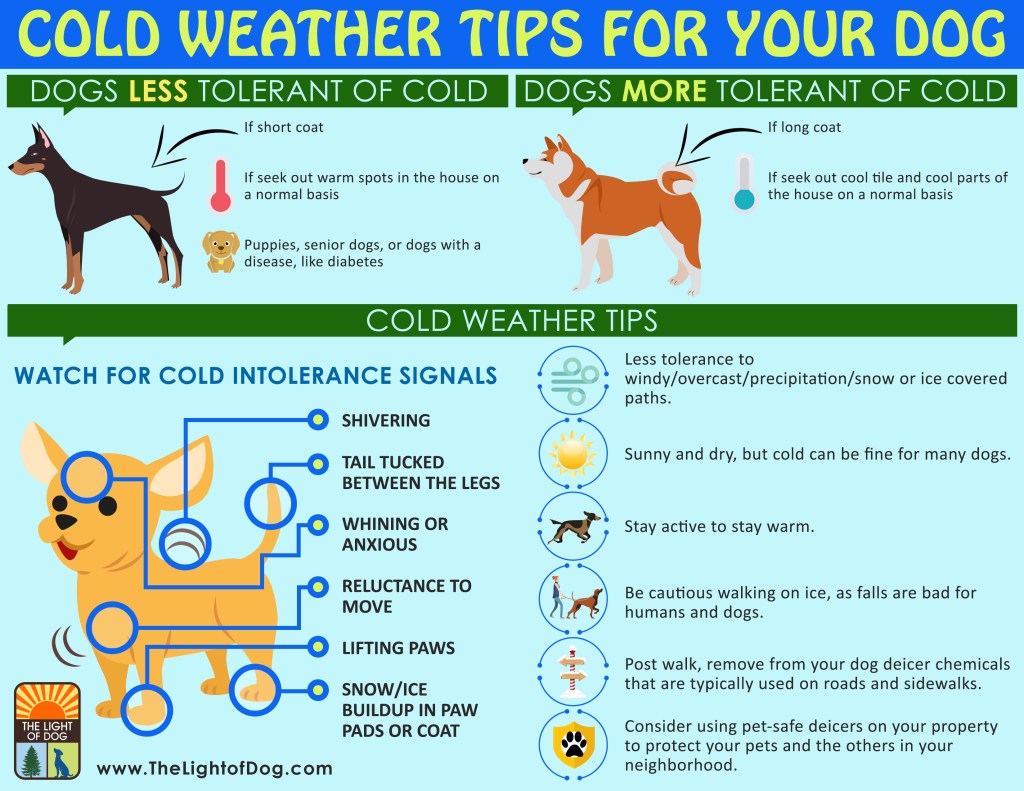
Did you know small dogs get colder faster in cold weather than larger dogs? It’s true, and for a number of reasons. That’s why it is so important to keep an eye on our little guys when the temps drop. Small dogs and cold weather can be a dangerous combination so make sure your dog stays warm and healthy.
Why Do Small Dogs Get So Cold?
There are several reasons our small dogs, especially tiny Toy breeds, are particularly cold intolerant.
Size – First and foremost, small dogs have smaller bodies. This contributes to them losing body heat much faster than larger dogs in a concept called surface area to volume ratio. Small dogs have a larger surface area to volume ratio meaning more skin surface to volume inside allowing for heat to escape faster. Apparently, I’m worse at science than I thought, and this is a hard concept for me to wrap my brain around. Basically, the smaller you are, the easier it is to lose body heat. Also, small dogs tend to be thinner (unless you’re like my Charlie who has never missed a meal). Less muscle to generate heat and less fat to insulate their tiny bodies means less help regulating body temperature.
Coat Type – Many of our little dogs, my Toy Poodles included, have a single coat. They are lacking that thick undercoat layer (for example, Husky or Malamute) to keep them insulated from the cold. Kind of like wearing a light coat or windbreaker vs a puffy down jacket in the middle of winter. The puffy one is going to keep you warmer, right?
Shorter – Toy breeds are closer to the ground which potentially puts more of their body in contact with snow and ice. My mom’s Chihuahua, Cassie has a difficult time in the snow and relies on her larger siblings (both Pit Bulls) to clear a path for her.
Other Contributing Factors To Cold Intolerance….

Shorter or Thinner Coats – Shorter and thinner coats provide less insulation from the cold. I don’t groom my Toy Poodles as much in the winter, purposely letting their coats grow longer to help keep them fluffy and warm. Some small dogs like Chihuahuas and Pugs don’t have this ability, their coats remain short and thin all year.
Coat Color – Lighter colored dogs may be more susceptible to cold because they don’t absorb as much heat as their dark-coated brothers. It’s the same concept as you wearing a light colored shirt in the summer. You’ll stay cooler because the lighter the color, the more heat (sun’s rays) is reflected.
Seniors – Just like humans, senior dogs have less fat and muscle to help insulate and regulate body temperature. Many seniors have arthritis and cold weather can make their joints feel even stiffer and more painful. This pain and stiffness can cause your senior dog to move slower, have less energy and exercise less; all contributing to decreased body temperature. Also, the risk of frostbite increases with your senior standing in one cold place because arthritis has made it too painful to walk.
Conditioning – Moving from one climate to another can contribute to cold intolerance. Think of it this way….someone growing up in Alaska might think it’s downright toasty when the temp hits 50 degrees while someone from SoCal feels like they are freezing to death. If your pup has grown up with cooler temps, most likely they’ll be able to tolerate a drop in temperature better.
Puppies – Like senior dogs, puppies have hard time regulating their body temperature increasing their risk of hypothermia.
Sick/Ailing – Dogs dealing with a weakened immune system from diseases such as diabetes or kidney disease are at greater risk to cold weather because they have a more difficult time regulating their body temp. This can cause a whole list of medical problems like irregular heartbeat and breathing issues.
Activity Level – Is your dog a couch potato or the champion of dog zoomies? Exercise generates heat so the more sedate your pooch is, the more likely they are to feel the chill.

Brachycephalic Dogs – Cold weather can increase breathing issues in small dogs with smushed faces like the Pekingese, Pug, and Shih Tzu who are already breathing compromised.
Weather – Have you ever noticed how 60 degress in the sun feels so much warmer than 60 degrees on a cloudy day? Cloudy, damp, wet or windy weather can all affect how we tolerate cold weather, our dogs included.
Can Small Dogs Handle Cold Weather?
Don’t rely on temperature alone, 40 degrees for one dog may be way too cold for another. There are also some telltale signs to watch out for to guide your decision on whether or not it’s too cold for your tiny dogs. A good rule of thumb: if it’s too cold for you, chances are it’s too cold for your dog.
- Shaking or shivering
- Reluctance to keep walking or tries to head back for home
- Hunched with tail tucked
- Whining or barking
- Slow movement
- Trying to seek shelter
- Difficulty walking
- Lifts paws off the ground
- Anxious behavior or just generally looks uncomfortable
Small Dogs and Cold Weather – How Cold Is Too Cold?
Generally speaking, tiny Toys begin to feel uncomfortable at 45 degrees. Outdoor exposure should be very limited at 32 degrees, and at 20 degrees the potential for hypothermia and frostbite greatly increases. I’ve put together a chart adapted from the Tufts Animal Conditioning and Care scale that you can use to help determine how cold is too cold.


Tips For Keeping Your Dog Warm
It is just not possible to keep your tiny dogs inside all winter. At some point they are going to need to pee, poop, sniff, and burn off some of that doggie energy. Here are some tips for keeping your dog warm during cold weather.
Bundle Up – Gear up in warm clothes for outings. Your pup may need a sweater, coat, or even a snowsuit depending on what kind of weather you are experiencing and how long you intend to be out. Always make sure your dog’s clothing is not restricting breathing, eyesight, or movement in any way.

Booties – Dogs have thicker skin and extra fat on their pads and a system that keeps their paws warm in cold weather, but for extra protection you could try booties. Now I’ve tried these things several times and not one of my Poodles has ever been happy about it, but your dog might be different. Booties protect your dog’s paws from cold weather as well as harsh winter chemicals like de-icers. If your dog hates booties, you might want to try a paw balm.
Paw Balm/Lotion – This is a wax that you rub onto your dog’s paw pads before going out. The wax acts as a barrier and protects against cold walking conditions and decreases the chance of hard packed snow getting stuck between their toes. I love this stuff and my Poodle Sparky never seemed to mind. Petroleum jelly would also work to keep their paw pads protected.
Limit Exposure – Several short “pee trips” throughout the day will limit their cold weather exposure and how long it takes them to warm back up once inside. If you can, wait for the warmest part of the day for outdoor activities.
Baths – Decrease baths during winter months. Cold weather and baths both increase dry skin and the time it takes to warm up. If your pup is starting to look and smell homeless, of course a bath is fine, just keep it short.
Dedicated Potty Area – If you live in a snowy area, try and shovel a spot (and a path to that spot) for your pups to do their business without having to walk/stand in the snow.
Indoor Potty – Sometimes it is just too dang cold to go outside. If that’s the case, providing an area inside for your pup to potty is helpful. Pee pads, artificial grass, or a real grass patch are all indoor options when it’s freezing outside.
Remove Wet Clothing – Wet clothing just helps perpetuate the cold. Remove and towel dry your pup right away.
Check Paws – Check paws after outings for cracks or bleeding from cold conditions or iceballs stuck between their toes. Many paw balms not only protect against the elements, but also help soothe dry cracked paw pads.
Wash Legs and Belly – Wash with warm water and dry thoroughly. Washing with warm water helps in several ways. It alleviates the chill and gets rid of iceballs caught in your pup’s fur or between toes. A quick wash will also get rid of harsh chemicals (like salt, icemelts, and deicers) they may have stepped in, before they have a chance to ingest them by licking their paws.

Clip Feet Not Body – We let our Poodle’s coats grow in the winter as this adds extra warmth. Now, I’m not talking letting their coats grow until they are unmanageable little Yetis, just keep them a little fluffier than the summer and this will help insulate. Clipping their feet will decrease the chance of snow and ice sticking to paw fur.
Provide Warm Bed and Blankets – A warm snuggly spot to retreat from cold weather is a must for our tiny guys. My mom’s Chihuahua Cassie has got it made (aka spoiled). During the winter, she has access to an electric blanket at all times and soft snuggly blankets that my mom frequently warms up in the dryer for her. I’m pretty sure I hear Cassie saying “and I am so worth it”.
Inside Exercises – Try some inside exercises to generate heat before heading outside. This will help your dog stay warmer longer in the cold.
Hypothermia and Frostbite
Hypothermia occurs when your body temperature drops below a certain point, commonly due to prolonged cold exposure. For dogs this point is 99 or 98 degrees (depending on what article you’re reading). Extreme shivering, weak pulse, sluggishness, confusion, pale skin, dilated pupils, decreased heart rate and respirations are some but not all, the signs and symptoms your pup may suffer from. If left untreated, hypothermia can lead to coma and death. Frostbite is the freezing of skin and underlying tissues and decrease in circulation. This condition occurs first in small exposed body parts. In dogs, frostbite will first affect ear tips, nose, scrotum, feet, and tail tip and can be extremely painful. Discoloration of affected area and/or cold and brittle to the touch, red swollen blistering area, touching the area causes pain; these are some of the issues your dog may be experiencing with frostbite. Although hypothermia and frostbite are rare, you should know the signs and symptoms, begin rewarming your dog and call your vet immediately if you suspect your dog is experiencing either condition.
In Conclusion….
Outdoor exercise and mental stimulation are important factors that help keep our dogs happy and healthy, but sometimes the weather just doesn’t want to cooperate. The key is keeping our little guys warm so they can safely enjoy the outdoors during cold weather.

